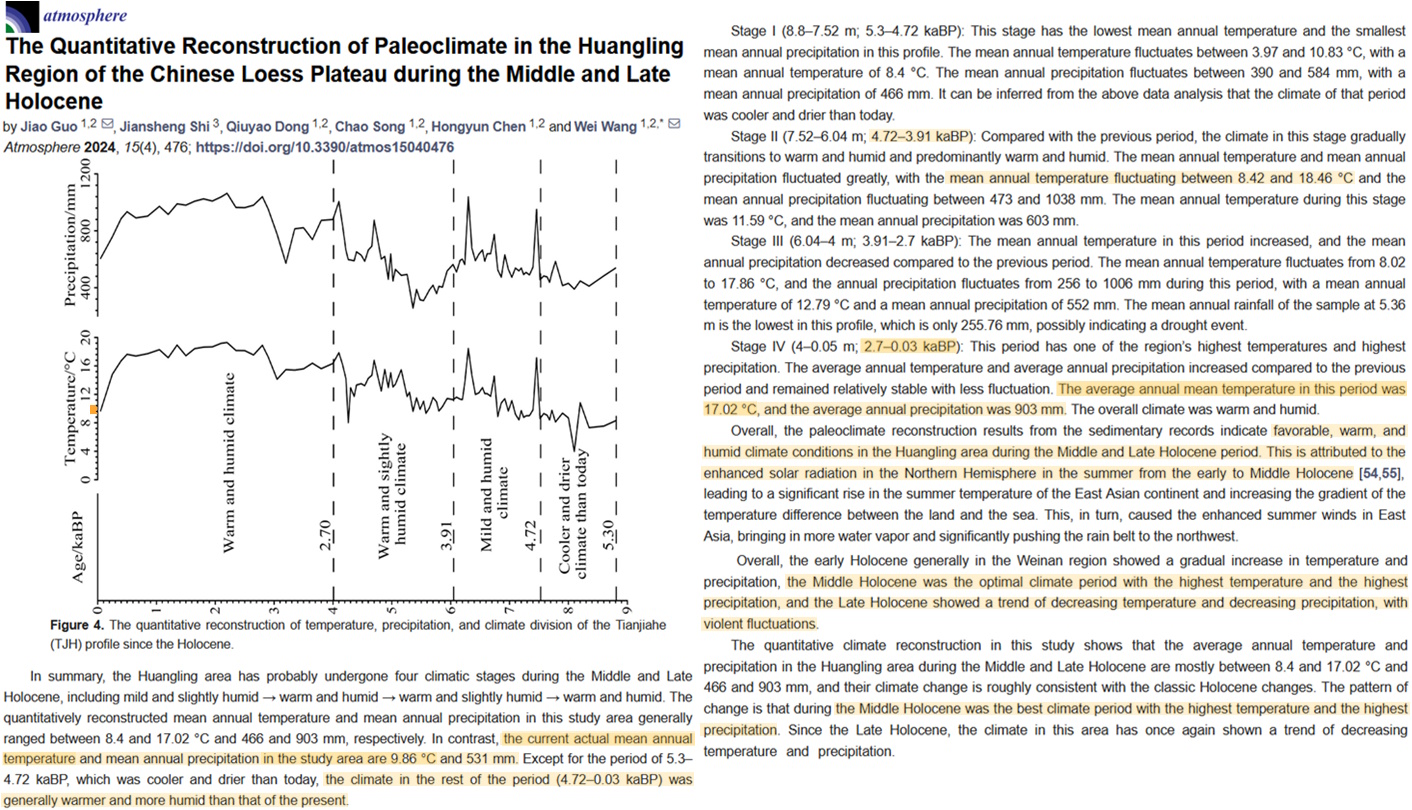Scientists refer to the Middle and Late Holocene’s much warmer and wetter regional climate as “favorable,” “optimal” and “the best.”
New research from a Loess Plateau study site identifies mean annual temperatures as 9.86°C today, while annual precipitation averages 531 mm. These values are shown to be among the coldest and driest of the last 5000 years.
In contrast, for the period extending from 2700 years ago to the last few centuries the mean annual temperatures were 17.02°C. This is 7.16°C warmer than present. The mean annual precipitation was 903 mm for this Late Holocene period, which is about 70% higher than today’s.
From about 4700 to 3900 years ago there were periods when mean annual temperatures varied up to 18.46°C, which is 8.6°C warmer than present.
The authors of this temperature and precipitation reconstruction note that the naturally warmer and wetter Middle and Late Holocene millennia were “the best,” most “favorable,” and “optimal” climate period when compared to the drier and colder climates of recent centuries.






1) Loess is an aolic sediment which has sedimented in Europe during ice age. It consists from crushed stone particles by glaciers movements. The dust was consolidated under the influence of rain water at the beginning of the wet Holozene (Pre-atlanticum, according to stalagmites the wettest and warmest period of the last 10.000 years). The oldest layer in this article in 6 m depth is 4105 years old, in 5,5 m it is 4160 years old. That means the soils in this loess region was built up during the minoan warm period, during the rise of oxus civilization and ripe Harapa stage. It was warm and wet. Black loam soil, mostly older than 4000 Years, is only generated during wet warm periods, when a thick humuslayer is built up. Black earth in steppes were built during atlanicum. Silty sand soils dominate during dry cold periods usually. Silty sand soils, created by sand storms or dry winters without snow cover, dominate the last 2 m and 2860 years. About 800 BC the (greek)colonisation from Syria into the mediterranean began caused by the expansion of the assyrian empire. Subclay dominated between 2800 – 3600 BP, that is the rise of the hethitic empire and of Mittani in northern mesopotamia and Anatolia. It should have been also wet but not so warm. Humus was not built up, strong monsun might have accelerated erosion of fine clay particles. Therefore it is not really Loess, but soil types built up under different water supply and temperature regime. 2) Pollenanalysis is a very specialist work and hat up for that. I did it myself. But in the published pollen spectrum i cant see any of the interpretations concerning temperature and water supply of figure 4. We have a clear separation between layer 0-4 m and layer 4-7,5 m and deeper undated layers. 0-4 m is the time younger than 3000 years . Unfortunately the layer in 4 m (Subclay) is older than the layer in 4,8 m (Black loam). So dating is rather unprecise. Pollendata show, that below 4 m until today we had a dry scattered Artemisia step desert vegetation dominated by Artemisia and a few pinus plots. 4-6 m: more dense forest-grass step with a lot of herbs and Ulmus and Salix showing wetter conditions and even Quercus, Juglans and Morus for a short period during minoan warm period. The deeper soil show lake vegetation, wet step vegetation and Pinus with Betula forests and a lot of ferns, so probably high monsun activities and milder winters. The deepest horizon is more Pinus -Betula pioneeer forests with step vegetation and less ferns. Selaginella is a bit confusing as it is usually an alpine element, which spores werde drifted far from the mountains. Therefore the c14-dating should be denser and calibrated. It is not written how old the layer in 9 m could be. The interpretation of the pollendiagram does not allow to say, that the last 2000 years have benn warm and wet, just the opposite. Vegetation was dry step with desert elements and only scattered trees. Around 4000 years ago it was the warmest and wettest period with Juglans and Morus which are an suboceanic element not made for cold winters. Before 4000 years, it was wet with probably colder winters and the layer in 8 m could show the situation after the long dry period of Piora II and I, which caused tribal migration. That it has been warmer and wetter with mild winters we can say for minoan period with Juglans. The dryest and coldest period has been during the last 3000 years (0-4 m), especially during 0,4 -2 m horizon with silty sand soils which show semiarid to arid conditions. So i dont unterstand why it should have been warm and humid in China while we had several cold periods such as celtic and hunnic cold period and little ice age. Pollen diagram and soils dont tell us this. Morus and Juglans dont bear cold winters, but they grow in the winter mild rhine valley and in wet lower level on the feet of Kaukasus. The warm and wettest period called Atlantikum is not represented in this study.
[…] From NoTricksZone […]
[…] – New Study: China’s Loess Plateau 7-8°C Warmer Than Today For Much Of The Last 4000 Years […]